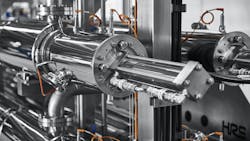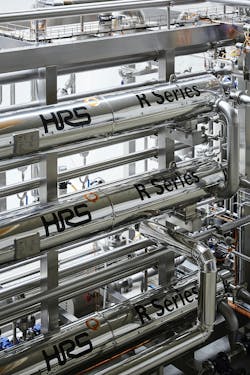How to choose the right heat exchanger for food processing applications
In the simplest terms, a heat exchanger is like a radiator, designed to heat (or cool) one material from another. However, over the last 150 years or so, a wide variety of types and designs have emerged, meaning that finding the most suitable type of heat exchanger for your application is not always simple.
All but the most basic heat exchangers are created to a bespoke brief, designed to consider the materials being heated or cooled, the heating or cooling medium, the amount of product being processed, product velocity, risk of fouling and a host of other factors. However, over the years some standard design types have emerged (as well as more specific types) and understanding the differences between these can make the specification process less of a mystery.
In this article, we guide you through the main types of heat exchangers produced by HRS and what applications and product types each is best suited to.
Key considerations
When specifying a heat exchanger, the first consideration is whether your application requires complete stainless-steel construction for hygiene reasons; for example, in the food and beverage industry.
Next, you should consider the nature of the material being processed, in particular its viscosity and whether it contains particles. The simpler and less viscous the material being processed, the simpler the heat exchanger can be. As materials become thicker, or contain suspended particles or large solids, then heat exchange becomes more difficult, and more sophisticated designs are required to guarantee the necessary performance. Starting with simple multi tube designs, the range moves through double tubes – where viscosity is higher or solids are present – and annular space designs for highly viscous products, to the most challenging materials (such as food stuffs containing pieces or very thick products like honey) requiring the use of scraped surface heat exchangers.
Another consideration is what happens in the event of a leak. In certain circumstances, particularly where the service fluid is not water, a leak can be business critical. In such cases, double tubeplate multitube heat exchangers should be specified, as these provide leak detection to avoid cross contamination between the service and product fluids.
Main heat exchanger types
Most heat transfer applications will require the use of corrugated tube heat exchangers. These offer several benefits over smooth tube designs – in particular, heat transfer and energy efficiency are increased (making them better for high-capacity heating or cooling). Fouling is also minimized meaning that units can be more compact and economical, and cleaning and servicing requirements are reduced.
For the most challenging applications (such as materials with high fouling potential, or where certain product characteristics are required), scraped surface heat exchangers are recommended. Depending on whether the product needs gentle handling or increased mixing, HRS offers rotating and reciprocating designs.
Corrugated tube heat exchangers
HRS produces three types of corrugated tube heat exchangers for food use:
- Annular space heat exchangers
- Double tube heat exchangers
- Multitube heat exchangers
Annular space heat exchangers are designed to ensure thorough heat transfer in high viscosity products. The product flows through the annular space between the inner and outer tubes, through which the service fluid flows to ensure even heating or cooling. As well as products with higher viscosity, the HRS AS Series is suitable for highly viscous fluids or those containing small particles, such as ketchup, honey, fruit jams and marmalades, as well as some dairy products and vegetable fats and oils.
Double tube heat exchangers consist of a tube within a tube and are among the most versatile corrugated tube heat exchangers. The HRS DTA Series is a true counter current stainless steel double tube heat exchanger. The DTA, and the new DTAR Series, are designed for more viscous products or products with large particulates in suspension, such as fruit mixes.
Multitube heat exchangers are the simplest design and carry the product in more than one interior tube, while the service fluid flows through the surrounding shell. HRS produces several different multi tube heat exchangers for use in a wide range of different industries and applications.
For food and beverage use, the HRS MI Series is suitable for products with low to medium viscosities; while for direct energy recovery, the HRS MR Series features removable tubes to allow hygienic processing on the shell side and is also suitable for products with low to medium viscosities. Where potential cross contamination is an issue, the HRS SH Series is a multitube shell and tube heat exchanger designed with the added security of a double tubeplate, providing leak detection to avoid cross contamination between the service and product fluids.
The HRS MP Series uses multiple passes on the tube side for greater flexibility for optimizing fluid velocity, pressure drop and heat transfer. The unique design creates longer thermal length within the same module, avoiding designs with multiple modules and interconnecting bends, and is ideal for applications involving low- to medium-viscosity fluids.
Scraped surface heat exchangers
Scraped surface heat exchangers (SSHEs) are the preferred choice for difficult heat transfer applications; for example, those with high viscosities and where fouling can become a problem.
HRS offers two types of SSHE
The patented Unicus Series is based on a traditional shell and tube heat exchanger, but with scraping elements inside each tube. The reciprocating movement of the scrapers mixes the fluid whilst cleaning the heat exchange surface. This keeps heat transfer high and reduces downtime. In addition, the scraping movements introduce turbulence in the fluid, increasing levels of heat transfer. The gentle movement of a range of scraper designs allows the Unicus to be used with delicate products, such as whole fruit or vegetable pieces, without destroying the product integrity.
In contrast, the HRS R Series is designed for very high viscosities and high fouling fluids. It uses a rotary scraper rod which can reach velocities of up to 300 rpm, resulting in very high levels of shear and mixing at the heat transfer surface, and dramatically increasing the heat transfer rate. A heavy-duty version (the HRS RHD Series) has also been developed for the most demanding applications with extreme viscosities. The R Series is ideal for very thick food products where thorough mixing is an advantage.

